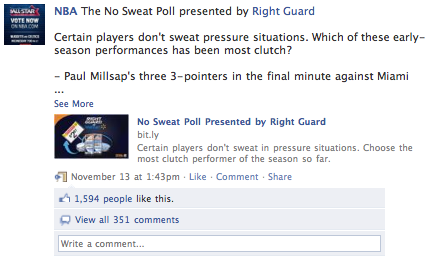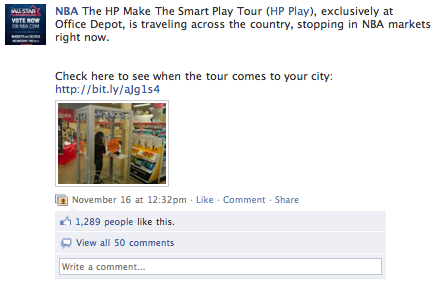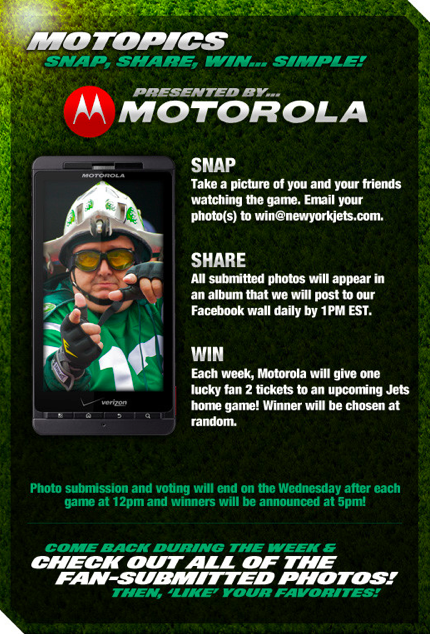Before I start, let me say that monetization should be far from the first concern for a brand when deciding to engage on Facebook, or with any aspect of social media. Social media is primarily about developing meaningful relationships with fans and consumers. It provides brands with the ability to humanize themselves, engage with consumers in a one-to-one manner, create trust, address customer concerns, and more. In the end, effective use of social media can lead to sales and other forms of monetization. But it takes time and patience. In this post, I’ll highlight how sports brands (specifically) can profit financially from an active Facebook community.
Step 1: Build It
As you can probably tell from the title of this post, there is a necessary process involved in monetizing Facebook in the way I propose. The first step is to build an active, engaged, passionate, and large (in numbers) Facebook page. Among other things, this takes a lot of time. As Gary Vaynerchuk, my company’s cofounder, said in a talk earlier this week, “The ROI of social media is patience.” Brands have to understand that large-scale monetization of social media takes a lot of time and effort. It takes finding fans of your brand to come, giving them reason to stick around, responding to their comments and questions and concerns, and being consistent. Most importantly, it involves creating trust, and not selling to them for as long as possible. I could write a book about how to build a Facebook community, but the point is that the necessary first step is to build a community that is not only sizable, but engaged and active on a daily basis.
Step 2: They Will Come
We’re in the midst of a social media gold rush. Some brands are finding ways to create massive social media properties. Others are struggling to find their way (maybe Suzy was bitten by a snake or broke her leg, or one of your oxen fell ill – Oregon Trail anyone?). The second part of the process involves activating partners and sponsors. For the brands who have found success, opportunities will surface (and in many cases have already surfaced) for them to leverage their own community to help a partner/sponsor in exchange for some amount of value (monetary or otherwise).
An active community that has not been sold to repeatedly consists of receptive fans. If the page provides good content and consistent interactions, fans won’t mind sponsored elements, especially if they are not obtrusive to the overall experience. Some examples:
Branded Status Updates
The NBA has been activating sponsors through Facebook since last season. One way they have done so is through branded status updates that link to the sponsor’s Facebook page. They leverage their 6.8 million fans for partners while creating content that is not disruptive for the user.
In this example, the NBA created a series called “The No Sweat Poll” that is presented by a sponsor (Right Guard).

In another situation, the NBA simply promotes a tour they’ve partnered with HP Play to put on.

Each example garnered over 1,200 likes and a good number of comments. And in each example, the brand partner was linked to within the status update, meaning that they probably picked up some fans for themselves. Granted, this number is likely low, but the impression total (and brand awareness garnered) is quite high.
Branded Facebook Tabs
For the 2010-11 regular season, the New York Jets (full disclosure: a client of ours) have been running a campaign in order to encourage fans to generate content. The campaign is sponsored by Motorola, and the coinciding Facebook page has been branded heavily with Motorola imagery.

A branded tab that is then promoted to the community can create a lot of brand awareness. Motorola has been the season-long sponsor for this campaign and has been seen by tens, if not hundreds of thousands, of eyeballs. And fans don’t mind the sponsored aspect of the campaign since the sponsor is providing a fun experience and rewarding them with prizes.
In Conclusion
In this “If you build it, they will come” model, the “it” is a powerful Facebook page and the “they” are partners/sponsors. Brands are increasingly interested in social media and this trend will not die soon. It will be years until every brand utilizes social media and even longer until every brand knows how to build a community there. These partnership opportunities will always exist, and as social media is seen more and more as an essential aspect of marketing, the financial gain from these opportunities will increase.
Obviously, this model is not the only way to monetize via social media. Selling merchandise and tickets is another way, but it’s not always easy to sell through social. The teams, leagues, and players that continue to build highly trafficked and active Facebook communities will earn chances to partner with other brands and monetize in 2011 and beyond.
###



Sam, I am with a social commerce software company, Moontoast. One of the biggest complaints we have heard from athletes and musicians is that they are helping Facebook and Twitter to drive traffic and revenue and not “participating” in it. This is one of the reasons why we created our Embedded Store – it allows athletes and musicians, as well as anyone else who sells digital or physical products, to merchandise and sell to their fans, wherever their fans are located online. While accumulating and tracking ‘likes’ and ‘shares’ are important, we believe it’s more important to track them as part of an overall social commerce conversion funnel (so we provide great analytics data along with best practices guidance to our clients). As long as our clients follow our advice about how to promote, how frequently to promote, and how to merchandise their social commerce stores, revenue is great and the stores go viral (fans actually share stores with other fans).
jeff
Our colon, liver, kidneys, gall bladder, and every other organ
in our body are running at the limit. Nutritional requirements during
detox are high as the body needs enough vitamins and minerals to cleanse
out the toxins. You may also experience these side effects in spite of drinking the prescribed water intake especially if the colon
cleanse products contain ingredients such as cascara sagrada.
If you use a product with senna in it, it is best to slowly “wean” yourself off the product, not
just suddenly stop using it. You don’t even need to go
running to seek the advice of any pharmacy or a doctor.
Even if you moved to a deserted island and only ate organic fruit and vegetables grown in your own garden,
you still cannot be sure that you’re completely safe from
pollution.
Having read this I believed it was extremely enlightening.
I appreciate you taking the time and energy to put this article together.
I once again find myself personally spending way too much time both reading and commenting.
But so what, it was still worthwhile!